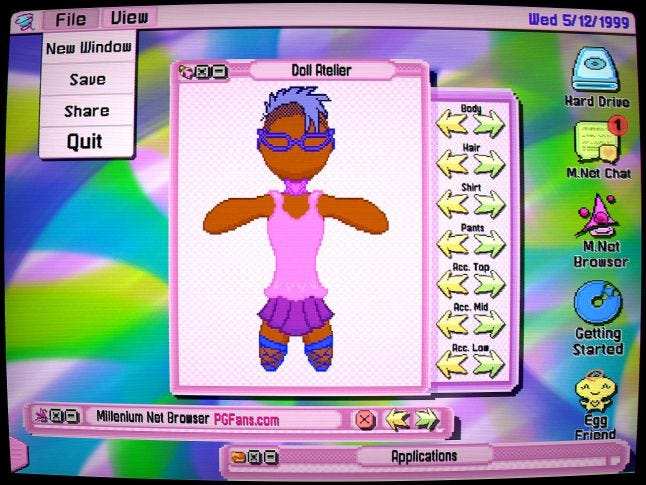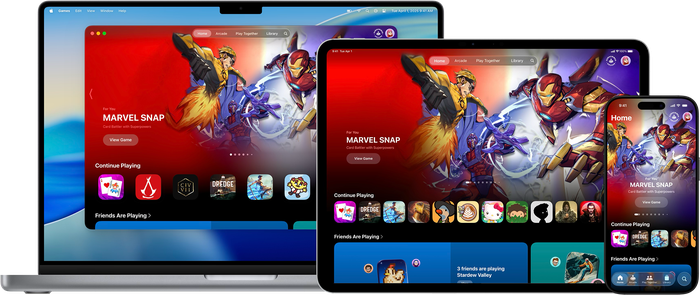"Computers are magical," says Victoria Dominowski, developer of Secret Little Haven, a game of personal discovery through chat rooms, the internet, and operating systems.
"Computers and the internet have always been an important part of my life, as well as the lives of lots of other trans people. In the absence of a means of expressing ourselves how we like in real life, we take to social spaces online, where we choose avatars that represent us better than our real bodies can. Forums and fansites are social spaces that can be participated in outside of the judgemental eye of parents, and offer many kids’ first sense of real social freedom - something which is especially important for trans people.”
Secret Little Haven follows Alex Cole, a young trans girl only just beginning to discover herself through the persona she creates online, as well as her interactions and actions on her computer and in the digital landscape.
It’s a notable story about Cole learning who she is through use of her computer, and to tell such a story, Dominowski set out to capture a real sense of using a computer and the internet in the game.
To do so Dominowski came up with SanctuaryOS, an operating system filled with programs, browsers, websites, text editors, doll makers, and other tools for players to mess around with and participate in. In doing so, Dominowski created a place for the player to discover the character, going along on Alex’s journey of self discovery using these tools at the same time. The player and Alex are both getting to know Alex’s true self through their online behavior.
<iframe title="Embedded content" src="https://giphy.com/embed/pzcEzuJ7WmtJ1syf00" height="100%px" width="100%" data-testid="iframe" loading="lazy" scrolling="auto"></iframe>“This freedom is empowering in a way that few other things are at that age," says Dominwoski. "The promise of an impossibly-vast internet to explore is breathtaking, especially at an age in which the world already feels brimming with possibility. This is why I felt the game’s SanctuaryOS was the perfect means by which to tell the story of my game.”
Learning about ourselves through our computers
Dominowski sought to tell Alex’s story through an operating system and the various programs and chat rooms that came along with it, mirroring the self-discovery she’d seen through online interactions and digital spaces in the trans community. Not only this, but a part of it was born out of facing her past self.
"I chose to design SanctuaryOS after Mac OS 9 - because to me, it represents a time of healing, empowering femininity, and acceptance."
“Getting into the specifics of SanctuaryOS’ Mac OS 9-inspired design, when I was much younger, still closeted, still ignorant of myself, and still associating with friends who were deeply ensconced in toxic masculinity as a cover for my real feelings, my friend used to make fun of Macintoshes for their more feminine appearance," says Dominwoski. "I always half-heartedly joked in return about it, playing along.”
“Years later, after I had moved on, confronted my feelings, and came out, I found an old bright pink iMac G3 in a thrift store running OS 9," she continues. "Upon exploring the system again, it felt fresh and new - uncharted territory all over again. I used that computer to explore a lot of the feminine media that I was too afraid to indulge in when I was much younger. I decorated it from head to toe with cute, girly things, and expressed myself through the use of the computer.”
“I feel like coming back with an open mind, no closeted and confused insecurities, and without the noxious pall of toxic masculinity looming overhead, I was finally able to make peace with my old self. This is why I chose to design SanctuaryOS after Mac OS 9 - because to me, it represents a time of healing, empowering femininity, and acceptance.”
This power, which had a tremendous healing and self-reflective effect on Dominowski, would be captured in the SanctuaryOS she created for Secret Little Haven. Like her own experiences, this mock computer would be a place where players could get to know themselves as Alex, a character that, like a person finding their true selves for the first time, we would come to meet, and truly accept, for the first time as well.

“By creating a space where the player is free to explore the computer and interact with others as they like, it allows them the same independence that the protagonist Alex feels,” says Dominowski. “We don’t know anything about Alex right up front - not what she looks like, where she lives, or what her life was like up until now. The only things you know about this character that you roleplay is what you can gather through dialogue choices, existing chat logs, and what you find on her computer. This instills a natural curiosity in the player, and gets them to learn more about her through the social actions that the game affords. Thus, players can empathize more strongly with her experiences by reflecting them on their own ones.”
Telling stories through an operating system
Still, how does one tell a story through an OS? How does someone get to know a character through their actions on a computer or through chat rooms and programs? How does one capture all of that through a created operating system? This was all a daunting task for Dominowski, but one that was integral to giving the player that feeling of self-discovery, with the OS being just as much a character as any other person in Secret Little Haven’s narrative.
“I wanted players to connect with SanctuaryOS like they would any of the game’s main characters, and that means putting in just as much effort into fleshing it out as a real thing as anyone else. I wanted players to feel that same sense of wonder that I felt when I was first discovering computers and the internet," she says. "I wanted them to feel like anything is possible in this new space, as long as they were willing to put in the effort to explore. I wanted this to tie into the characters’ arcs of self-discovery and independence. I wanted SanctuaryOS to be magical.”
"It is innately fun to discover things. I aimed to bring that experience to everyone, and to make them feel that same sense of computer magic I first felt so long ago."
Luckily, setting up a computer interface to interact with creates a natural starting ground for most players. After all, if they’re playing Secret Little Haven at all, they’re already sitting at a computer.
“Computer interfaces are enough of a well-understood paradigm that people can jump right in and get a good sense of how to accomplish their goals. They use their actual computer on a daily basis, and thus, it is easier for them to create a bond with SanctuaryOS. If you manage to maintain the illusion of a cohesive world, then you’ve already done a big part of the work of getting players emotionally invested.”
However, not everything about the OS landscape Dominowski created was immediately comprehensible to its players. Drawing from older Macintosh OS’ meant that some aspects might not have been immediately clear to players, something Dominowski discovered through playtesting.

“I spent countless hours watching testers do nothing other than explore SanctuaryOS and seeing how they interacted with the system’s UX principles. Often, I would find UX paradigms that didn’t make sense to users, and required me to make miniature tutorials, or make some UI elements fit more in line with modern paradigms.” says Dominowski.
These tests would show her a handful of problems with Secret Little haven, helping her smooth out some aspects players might not understand, helping make the transition from their own OS to that of SanctuaryOS that much smoother, allowing the player to feel more like they’ve inhabited the character. After all, what is the difference between player and character when both are sharing a space using the computer?
“The System Menu Bar in particular was a big problem to many users who have only ever seen or used a Windows machine - many users didn’t even notice it until the game points out its presence as it is relevant to a puzzle. I had to go far out of my way to call it out as an important UI element early on in the game," says Dominowski. "For a smaller example, I used to model each windows’ minimize/close buttons after those of Mac OS 9, upon which SanctuaryOS is heavily based. But as these symbols have been out of the greater computer users’ consciousness for so long, they became inscrutable to players. I had to change them to reflect the more standard X/- notation of Windows systems.”
Players, in playing around on SanctuaryOS, would come to learn more about the character through their own curiosity and their explorations of the computer itself. This was helped along by Dominowski’s only enjoyment for creating digital playgrounds, for what is a computer if not an array of things to interact with and discover?
“People have told me that as a designer, I am the type to make playgrounds. This means that rather than narrow in on a single mechanic and flesh it out into an entire game," says Dominowski. "I prefer to make spaces of possibility for players to peruse at their leisure. The games that have inspired me the most over the years have been friendly, yet somewhat mysterious places to explore filled with lots of charming distractions and the tantalizing promise of the unknown.”

A screencap from the Nintendo 64DD game Mario Artist: Polygon Studio, released in 2000 in Japan
“Games like Nintendo’s unsung N64DD classic, Polygon Studio, which
No tags.

































